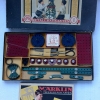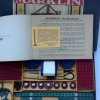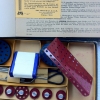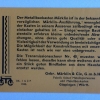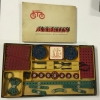MARKLIN > Outfits > 1 F 1942 de
Scatola 1F 1942 Germania
Acquistata negli USA il :03 nov 2014
Si tratta della migliore di due scatole #1F Marklin prodotte nel 1942 durante la WWII. Le scritte tipo Arial sono le stesse della scatola del motore a molla 201F, sola scatola anteguerra ad essere venduta nel dopoguerra. Sono nuove anche se le scatole ed i coperchi hanno sofferto (un coperchio manca di un lato corto).
Sono entrambe complete ed una ha ancora la scatoletta delle viti sigillata; entrambi i manuali 71a (codice RN 1039 i) sono nuovi. All’interno di uno dei due manuali vi è un foglietto giallo datato 1942, che avvisa che a causa della guerra la qualità generale del prodotto può diminuire, che vi possono essere differenze nei singoli pezzi e che il cordino #40 non è stato inserito nella scatola. Conclude però che tutto questo non inficia la superiorità del prodotto Marklin, beato lui!
Da un esame approfondito la qualità generale è molto scarsa, viti e dadi sono zincati in maniera molto approssimativa e variabile da pezzo a pezzo, rondelle e fermagli sono come quelli Mecano ma realizzati con lamierini sottilissimi, il manuale è stampato su pessima carta riciclata, i cartoni, i chiodi e le rondelle di fissaggio, così come scatola e coperchio sono molto scadenti e lontanissimi dalla qualità Marklin dell’anteguerra.
La presenza del foglietto del 1942 certifica che la scatola è stata comperata in Germania e poi portata negli USA, probabilmente da un cittadino tedesco emigrato dopola guerra o da un militare americano.
Rispetto all’altra scatola #1 acquistata sempre negli USA la sola differenza sta nel manuale che è in tedesco stampato su carta pessima e nella piastra flangiata #52 11×5 fori che, in queste, ha tutti i fori tondi ed i bordi arrotondati, ed è identica a quella Meccano, mentre nella prima è quella tipica Marklin.
Si deduce quindi che dopo il 1939, con l’entrata in guerra, la qualità decade (viti e dadi stagnati, rondelle piccole, ruote rosse in lamierino) e che nel 1942 vi è l’ulteriore modifica della piastra #52 e della carta riciclata.
La diversità di rondelle, fermagli e soprattutto piastra #52 può essere spiegata con il fatto che forse i pezzi venivano fatti non solo a Goppingen, ma anche nelle fabbriche di giocattoli delle nazioni occupate (Meccano France?).
Outfit 1F 1942 Germany
Purchased in the US: November 3, 2014
This is the best of two boxes #1F (farbig=color) Marklin produced in 1942 during WWII. The characters type Arial are the same as the box for the clockwork motor #201F, the only pre-war set to be sold after the war. Both the outfits are new even though the boxes and lids have suffered (a lid lacks a short side).
They are both complete and one still has the box of screws sealed; both 71a manuals (RN code 1039 i) are new. Inside one of the two manual there is a yellow sheet of paper dated 1942, which warns that because of the war, the general quality of the product may decrease, that there may be differences in individual pieces, and that the cord #40 was not included in box. however it concludes that this does not invalidate the superiority of Marklin product, lucky him!
Having examined the overall quality is very poor, screws and nuts are galvanized in very rough and variable piece by piece, washers and clips are like those Mecano but made with thin steel sheet, the manual is printed on bad recycled paper, the cartons, nails and lock washers, as well as case and cover are very poor and far away from the prewar Marklin quality.
The presence of the 1942 leaflet certifies that the box was bought in Germany and then brought to the US, probably by a German citizen who emigrated after the war or an American military.
Compared to the other set #1 always purchased in the US the only difference is in the manual that is in German language printed on bad paper and in the flange plate #52 (11×5 holes) that has all the holes round and rounded edges, and it is identical to that Meccano, while the first is the typical Marklin.
It therefore follows that after 1939, with the German entry into the war, the quality fall down (screws and tinned nuts, washers small, red wheels in the plate) and that in 1942 there is a further modification of the plate #52 and the use of recycled paper.
The diversity of washers, clips and especially plate #52 can be explained by the fact that maybe the pieces were made not only in Goppingen, but also in toy factories of occupied nations (Meccano France?).
- MARKLIN Outifits 1 F 1942 de (1)
- MARKLIN Outifits 1 F 1942 de (1)
- MARKLIN Outifits 1 F 1942 de (1)
- MARKLIN Outifits 1 F 1942 de (1)
- MARKLIN Outifits 1 F 1942 de (1)

